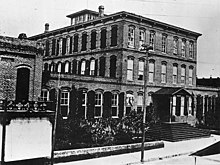The discovery of phosphate, the arrival of Plant's railroad, and the founding of Ybor City and West Tampa—all in the mid-1880s—were crucial to Tampa's development. The once-struggling village of Tampa became a bustling boomtown almost overnight, and had grown into one of the largest cities in Florida by 1900.[43]
Plant's railroad
Henry B. Plant's narrow-gauge South Florida Railroad reached Tampa and its port in late 1883, finally connecting the small town to the nation's railroad system after years of efforts by local leaders. Previously, Tampa's overland transportation links had consisted of sandy roads stretching across the Florida countryside. Plant's railroad made it much easier to get goods in and out of the Tampa Bay area. Phosphate and commercial fishing exports could be sent north by rail[44] and many new products were brought into the Tampa market, along with the first tourists.
Ybor's 1st Cigar Factory c. 1900
Ybor's cigars
Child labor at a cigar factory, 1909. Photo by Lewis Hine.
See also: History of Ybor City
The new railroad link enabled another important industry to come to Tampa. In 1885, the Tampa Board of Trade enticed Vicente Martinez Ybor to move his cigar manufacturing operations to Tampa from Key West. Proximity to Cuba
made importation of "clear Havana tobacco" easy by sea, and Plant's
railroad made shipment of finished cigars to the rest of the US market
easy by land.[43]Since Tampa was still a small town at the time (population less than 5000), Ybor built hundreds of small houses around his factory to accommodate the immediate influx of mainly Cuban and Spanish cigar workers. Ybor City's factories rolled their first cigars in 1886, and many different cigar manufacturers moved their operations to town in ensuing years. Many Italian and a few eastern European Jewish immigrants arrived starting in the late 1880s, opening businesses and shops that catered to cigar workers. By 1900, over 10,000 immigrants had moved to the neighborhood. Several thousand more Cuban immigrants built West Tampa, another cigar-centric suburb founded a few years later by Hugh MacFarlane. Between them, two "Latin" communities combined to exponentially expand Tampa's population, economic base, and tax revenues, as Tampa became the "Cigar Capital of the World".[45]
Franklin Street, looking north past the old Hillsborough County Courthouse, Tampa c. 1910s–1920s
Early 20th century
During the first few decades of the 20th century, the cigar-making industry was the backbone of Tampa's economy. The factories in Ybor City and West Tampa made an enormous number of cigars—in the peak year of 1929, over 500,000,000 cigars were hand rolled in the city.[46]In 1904, a local civic association of local businessmen dubbed themselves Ye Mystic Krewe of Gasparilla (named after local mythical pirate Jose Gaspar), and staged an "invasion" of the city followed by a parade. With a few exceptions, the Gasparilla Pirate Festival has been held every year since.[47]
Bolita and organized crime
Beginning in the late 19th century, illegal bolita lotteries were very popular among the Tampa working classes, especially in Ybor City. In the early 1920s, this small-time operation was taken over by Charlie Wall, the rebellious son of a prominent Tampa family, and went big-time. Bolita was able to openly thrive only because of kick-backs and bribes to key local politicians and law enforcement officials, and many were on the take.[48]Profits from the bolita lotteries and Prohibition-era bootlegging led to the development of several organized crime factions in the city. Charlie Wall was the first major boss, but various power struggles culminated in consolidation of control by Sicilian mafioso Santo Trafficante, Sr., and his faction in the 1950s. After his death in 1954 from cancer, control passed to his son Santo Trafficante, Jr., who established alliances with families in New York City and extended his power throughout Florida and into Batista-era Cuba.[49][50]
The era of rampant and open corruption ended in the 1950s, when the Estes Kefauver's traveling organized crime hearings came to town and were followed by the sensational misconduct trials of several local officials. Although many of the worst offenders in government and the mob were not charged, the trials helped to end the sense of lawlessness which had prevailed in Tampa for decades.[48]



No comments:
Post a Comment